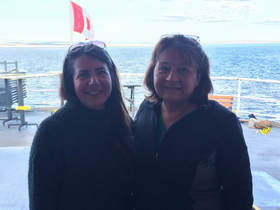|
In the Winter of 2019 I set off very excitedly, and rather naively given what was to come for my Fulbright residency in Seattle at the University of Washington. I wasn't settled more than two weeks, when the university closed its doors to face-to-face classes and shortly thereafter the global pandemic was declared. As we hunkered down and tried to figure out what could be done with the residency, when it was clear I was soon to be called home, one of the first things we had to re-plan was the "Fulbright Lecture". Traditionally the annual lecture at the University of Washington is a face to face event, held in a large lecture hall, with special guests and the public listening to the resident Fulbright "expert" talking about the project which brought them to Seattle. From the get go, this format didn't sit well with me, and I had planned to bring a colleague/ grad student/research associate with me. We'd booked her flights to visit and together we were to travel onward to Alaska for a conference, but well that didn't work out. So in discussion, the Director of the Canadian Studies Centre within the Jackson School of International Studies (my host- Nadine Fabbi) and I came up with a new alternative to the singular voice of the "expert". Instead I gathered together a panel of speakers, all from Nunatsiavut, to talk about Inuit education from their perspectives in a live virtual presentation. The members were: Diane Obed (my original co-speaker) a graduate student originally from Hopedale; Doris Boase a teacher, also originally from Hopedale, and Jodi Lane the Education Manager for the Nunatsiavut Government. Together these three women spoke about Inuit education in a way that I never could. Because at this point, giving a large scale Zoom presentation was something we were all quite new with, the event was by invitation only. The goal was to keep it smaller, more intimate so that authentic conversations and questions could emerge, questions that might not appear in a large lecture hall. To be honest, I am so much more pleased with this version of the presentation than the one we originally planned, so in the end, the disaster created a beautiful opportunity for highlighting the voices of Nunatsiavut in a much stronger way. We did however record the session and you can watch it here, and judge for yourself :
https://www.youtube.com/watch?v=huIp6xjVzJg
0 Comments
Dr. Tanya Brann-Barrett the Dean of Research, Teaching and Graduate Studies at CBU and I spent some time last week talking with researchers and Instructional Designers about the evolution of CBU's strategy for open education. You can watch and listen to the recorded session at: https://landing.athabascau.ca/groups/profile/289790/cider/tab/359765/sessionsat
|
Author@kathymesnow Archives
January 2018
Categories |

 RSS Feed
RSS Feed
